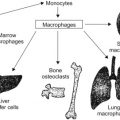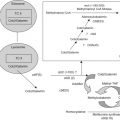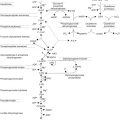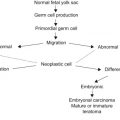Abstract
Myelodysplastic syndromes (MDS) are clonal hematopoietic stem cell disorders characterized by varying degrees of cytopenias secondary to ineffective and dysplastic hematopoiesis and increased propensity to evolve into acute myeloid leukemia. In contrast to adult MDS patients, who usually present with a hypercellular bone marrow (BM), the majority of pediatric MDS patients present with a hypocellular BM, making them difficult to distinguish from acquired and inherited BM failure disorders.
Keywords
Myelodysplastic syndrome, acute myeloid leukemia, myeloproliferative neoplasms (MPN), bone marrow failure, Down syndrome, JMML
Myelodysplastic Syndromes
Myelodysplastic syndromes (MDS) are clonal hematopoietic stem cell disorders characterized by varying degrees of cytopenias secondary to ineffective and dysplastic hematopoiesis and increased propensity to evolve into acute myeloid leukemia (AML). In contrast to adult MDS patients, who usually present with a hypercellular bone marrow (BM), the majority of pediatric MDS patients present with a hypocellular BM, making them difficult to distinguish from acquired and inherited BM failure disorders (IBMFS) (see Chapter 8 ).
Diagnostic Criteria and Classification
Table 17.1 provides diagnostic criteria for pediatric MDS.
At least two of the following
|
The classification of MDS has been updated over the years to accommodate for newer diagnostic findings. Table 17.2 provides the historical evolution of the MDS classification and compares the French–American–British (FAB) classification with the 2001 and 2008 World Health Organization (WHO) classifications and diagnostic criteria. The 2008 WHO classification introduced a pediatric MDS classification for the first time. Refractory cytopenia of childhood (RCC) was proposed as the most common subtype of pediatric MDS, accounting for about 50% of cases. The majority of RCC patients have normal cytogenetics and present with a hypocellular BM with varying degrees of dysplasia resembling BMF. Higher-grade pediatric MDS include refractory anemia with excess blasts (RAEB) and refractory anemia with excess blasts in transformation (RAEB-T).
| FAB (1982) | WHO (2001) | WHO (2008) | WHO (2008) diagnostic criteria |
|---|---|---|---|
| RA | RA | RCUD (includes RA, RN, RT) | |
| RA | RA | RA | Anemia (Hb <10 g/dl); ±neutropenia or thrombocytopenia; <1% circulating blasts; <5% medullary blasts; unequivocal dyserythropoiesis in ≥10% erythroid precursors; dysgranulopoiesis and dysmegakaryopoiesis, if present, in <10% nucleated cells; <15% RS; no Auer rods |
| n/a | n/a | RN | Neutropenia (absolute neutrophil count <1.8×10 9 /l); ± anemia or thrombocytopenia; <1% circulating blasts; <5% medullary blasts; ≥10% dysplastic neutrophils; <10% dyserythropoiesis and dysmegakaryopoiesis; <15% RS; no Auer rods |
| n/a | n/a | RT | Thrombocytopenia (platelet count <100×10 9 /l); ± anemia or neutropenia; <1% circulating blasts; <5% medullary blasts; ≥10% dysplastic megakaryocytes of ≥30 megakaryocytes; <10% dyserythropoiesis and dysgranulopoiesis; <15% RS; no Auer rods |
| RARS | RARS | RARS | Anemia; no circulating blasts; <5% medullary blasts; dyserythropoiesis only, with RS among >15% of 100 erythroid precursors; no Auer rods |
| n/a | RCMD | RCMD | Cytopenia(s); <1×10 9 /l circulating monocytes; <1% circulating blasts; <5% medullary blasts; dysplasia among >10% cells of ≥2 lineages; no Auer rods |
| and RCMD with RS | n/a | n/a | |
| RAEB | RAEB-1 | RAEB-1 | Cytopenia(s); <1×10 9 /l circulating monocytes; <5% circulating blasts; 5–9% medullary blasts; dysplasia involving ≥1 lineage(s); no Auer rods |
| RAEB | RAEB-2 | RAEB-2 | Cytopenia(s); <1×10 9 /l circulating monocytes; 5–19% circulating blasts; 10–19% medullary blasts; dysplasia involving ≥1 lineage(s); ± Auer rods a |
| n/a | n/a | RAEB-F | Similar to RAEB-1 or RAEB-2, with at least bilineage dysplasia and with diffuse coarse reticulin fibrosis, with or without collagenous fibrosis |
| RAEB-T (blasts 20–29%) | (AML) | (AML) | n/a |
| n/a | MDS, U | MDS, U | RCUD with 1% circulating blasts OR pancytopenia with unilineage dysplasia OR<1×10 9 /l circulating monocytes,≤1% circulating blasts,<5% circulating blasts, dysplasia in <10% cells of ≥1 lineage(s) and demonstration of MDS-associated chromosomal abnormality(ies), exclusive of +8, del(20q), and loss of chromosome Y (-Y) |
| MDS, isolated del(5q) | MDS, isolated del(5q) | Anemia; platelet count may be normal or increased; <1% circulating blasts; <5% medullary blasts; megakaryocytes with characteristic nuclear hypolobulation; isolated del(5q) cytogenetic abnormality involving bands q31–q33 | |
| CMML | (MDS/MPN) | (MDS/MPN) | n/a |
| n/a | n/a | RCC | Thrombocytopenia, anemia, and/or neutropenia; <2% circulating blasts; <5% medullary blasts; unequivocal dysplasia in ≥2 lineages, or in >10% cells of one lineage; no RS |
a In the FAB Classification, the presence of Auer rods is one of the criteria for RAEB-T regardless of the number of blasts.
Juvenile myelomonocytic leukemia (JMML) and MDS associated with Down syndrome (DS), previously grouped under MDS, are now recognized as distinct entities and are therefore classified and discussed separately. Table 17.3 provides the diagnostic categories of MDS and myeloproliferative neoplasms in children.
|
Epidemiology
Incidence: 1.8 per million children per year in age group 0–14 years.
Constitutes 4% of all hematological malignancies.
Table 17.4 provides constitutional and acquired abnormalities associated with secondary pediatric MDS. Primary MDS occurs de novo without an apparent underlying cause.
| Conditions associated with MDS |
|---|
| INHERITED CONDITIONS |
|
| ACQUIRED CONDITIONS |
|
a Familial cases of MDS not due to GATA2, ETV6, RUNX1/AML1, CEBPA.
b A subset of cases currently classified as acquired aplastic anemia might be due to in underlying genetic predisposition and may in the future be considered as an inherited condition.
Familial MDS has been observed in 10% of children with MDS, but is likely more frequent than previously considered. It is commonly associated with partial or complete loss of chromosome 7 (7q- or monosomy 7), particularly in association with GATA2 mutation.
Therapy-Related Myeloid Neoplasms
In the 2008 WHO Classification, this category includes therapy-related acute myeloid leukemia (t-AML) and therapy-related MDS (t-MDS). These disorders occur secondary to treatment with alkylating agents, topoisomerase II inhibitors, other chemotherapeutic agents, and radiation therapy.
- •
Alkylating agents- and ionizing irradiation-induced MDS are characterized by deletions or loss of whole chromosome or complex cytogenetics. Latency period: 5–10 years.
- •
Topoisomerase II inhibitor-induced MDS is characterized by balanced translocations, commonly involving chromosome band 11q23, which harbors the MLL gene. Latency period: 1–3 years.
Incidence of therapy-related MDS: represents 5% of all childhood MDS and occurs in 13% of children treated for malignancies.
Children with t-MDS or t-AML compared to children with de novo AML or MDS, have the following characteristics:
- 1.
Older at presentation, have lower white blood cell (WBC) counts, and are less likely to have hepatomegaly or splenomegaly or hepatosplenomegaly.
- 2.
More likely to have trisomy 8 and less likely to have classic AML translocations.
- 3.
Less likely to attain remission after induction therapy (50% vs 72%) and less likely to have a longer overall survival (OS) (26% vs 47%), and event-free survival (21% vs 39%).
Their disease-free survival (DFS) after attaining remission is similar to children with de novo AML or MDS (45% vs 53%).
Pathophysiology
MDS is a heterogeneous disease with different pathophysiologic mechanisms playing roles in its initiation and progression. Initially, apoptosis dominates the process and is responsible for the characteristic ineffective hematopoiesis. With time, as more genetic abnormalities accumulate in the MDS cells, arrest of maturation and proliferation occurs, resulting in transformation to AML. Recent evidence suggests that an underlying inherited predisposition (germline mutations, e.g., GATA2 ) is the disease-initiating event in a subset of patients with pediatric MDS. In those cases secondary acquired somatic mutations may lead to disease progression.
Clinical Features
The clinical presentation can be variable. A third of the patients are asymptomatic and come to medical attention because of an incidental finding of cytopenia. If symptoms occur they are usually related to cytopenias, for example, pallor, bruises, petechiae, infections. In contrast to adults that frequently present with anemia, children typically present with thrombocytopenia, neutropenia, macrocytosis, and sometimes show an elevated fetal hemoglobin levels. Lymphadenopathy or hepatosplenomegaly are uncommon and are associated with advanced disease.
Cytogenetics
- •
The presence of a clonal cytogenetic marker can confirm the diagnosis; however, about 61–67% of patients with RCC have normal cytogenetics.
- •
Monosomy 7 is the most common cytogenetic abnormality in childhood MDS followed by trisomy 8.
- •
Aberrations in chromosome 5, in particular the 5q- syndrome commonly seen in adults, is rare in children.
- •
Monosomy 7 and complex karyotype (≥three abnormalities) have been associated with increased risk for leukemic transformation and poor prognosis.
The concept of monosomy 7 as a distinct syndrome has been abandoned. A subset of these cases ultimately fit the diagnosis of JMML. Another subset of cases initially reported as “monosomy 7 syndrome” were cases of familial MDS/AML and were likely due to GATA2 haploinsufficiency in a significant portion of the cases.
Molecular Genetics
In adult MDS, somatic mutations in splicing factors ( SF3B1, U2AF1, ZRSR2 ) and epigenetic regulators ( TET2, ASXL1, EZH2, DNMT3A, IDH1/IDH2 ) are present in about 75% of cases, followed by isolated TP53 mutations and mutations in a variety of other genes including transcription factors ( RUNX1, ETV6, GATA2, PHF6 ), kinase signaling ( NRAS, KRAS, JAK2, CBL ), and cohesion complex genes. Interestingly, mutations commonly found in adult MDS, particularly genes controlling the RNA splicing machinery and epigenetics, are only rarely present in pediatric MDS, suggesting different pathogenic mechanisms between the two groups. This evidence and the recent discovery of germline mutations in RUNX1/AML1, GATA2 , and ETV6 suggest that pediatric MDS is more frequently due to an inherited genetic predisposition.
Recent studies suggest a role for epigenetics in both adult and pediatric MDS, resulting in gene silencing through methylation or histone deacetylation.
Differential Diagnosis
- 1.
It is to be noted that dysplastic features may be seen in non-MDS diseases, such as immunologic, rheumatologic, metabolic, mitochondrial (e.g., Pearson syndrome) and nutritional disorders, viral infections, and drug or toxin exposure.
- 2.
Some degree of dyspoiesis/dysplasia can be seen in IBMFS. Given the different treatment strategies and clinical implications these need to be ruled out by molecular testing in all patients with suspected MDS.
- 3.
It is difficult to distinguish hypocellular RCC from acquired aplastic anemia. The 2008 WHO Classification has established criteria to discriminate between both entities (summarized in Table 17.5 ). It is important to note that RCC currently remains a provisional entity for which the clinical and prognostic implications remain under investigation.
Table 17.5
Histopathologic Criteria of Hypocellular Refractory Cytopenia of Childhood (RCC) and Severe Aplastic Anemia (SAA) as Outlined in the WHO Classification
Lineage characteristics
RCC
SAA
Erythroid
Patchy, left-shifted erythropoiesis with increased mitoses
Lacking foci or left-shifted erythroid cells or only showing single small focus of <10 cells of erythroid cells with maturation
Myeloid
Markedly decreased, left-shifted myelopoiesis
Lacking or markedly decreased myelopoiesis with very few small foci of granulopoiesis with maturation
Megakaryocytes
Markedly decreased megakaryopoiesis
Lacking or only very few megakaryocytes present
Dysplastic changes (micromegakaryocytes) a
No dysplastic changes or micromegakaryocytes a
Lymphoid
Lymphocytes, PC, MC may be focally increased or dispersed
Lymphocytes, PC, MC may be focally increased or dispersed
CD34+ cells
Not increased
Not increased
Adapted from the 2008 WHO classification.
a Immunohistochemistry with CD61 staining is required for the detection of micromegakaryocytes. PC, plasma cells; MC, mast cells.
- 4.
The majority of children who develop MDS following a diagnosis of acquired aplastic anemia present with MDS within the first 3 years from the diagnosis of aplastic anemia.
- 5.
Patients with mild to moderate aplastic anemia may be more likely to develop a clonal disease than a patient with severe aplastic anemia. Repeated evaluation for both conditions including BM examinations may become necessary to reach a diagnosis.
- 6.
If ringed sideroblasts are observed in a pediatric BM with concern for MDS or BMF, a search for other etiologies, particularly nutritional deficiencies, drug toxicity, congenital sideroblastic anemias, especially those related to mitochondrial cytopathies, including Pearson marrow-pancreas syndrome should be considered as refractory anemia with ringed sideroblasts (RARS), is rare in children.
- 7.
Clinical course and the response to therapy for de novo AML are different from advanced MDS with excess blasts (RAEB). For this reason, it is important that these conditions are diagnosed accurately.
- 8.
The MDS subtype RAEB-T has been abandoned in adults. However, that term is still in use for pediatric patients, particularly for those patients with a slowly progressive disease rather that the classic abrupt course of AML.
Table 17.6 highlights some investigations and other diagnostic possibilities in patients suspected of having MDS.
|
a Draw blood for hemoglobin fractionation studies, paroxysmal nocturnal hemoglobinuria panel, and adenosine deaminase (if macrocytosis), before transfusing patient with red blood cells.
b Patients with Fanconi anemia may present with MDS. The significance of this observation is that all patients with MDS should have chromosomal breakage analysis performed to exclude Fanconi anemia because Fanconi anemia is a recessive disorder and warrants genetic counseling. Additionally, preparative regimen for hematopoietic stem cell transplantation is different for patients with Fanconi anemia.
c Bone marrow trephine biopsy: Biopsy may help differentiate refractory cytopenia of childhood from acquired aplastic anemia. Two additional types of MDS have been recognized recently. (A) Hypoplastic MDS and (B) MDS with myelofibrosis. Also, in some reports emphasis is placed on recognizing abnormal location of immature precursor cells, that is, presence of blasts in intertrabecular areas in bone marrow biopsy specimens, since it may have prognostic significance. However, no significance has been found thus far, in the major reports of pediatric MDS series.
Prognosis
- •
Monosomy 7 and complex karyotype (≥3 abnormalities) are known to be associated with increased risk for disease progression to leukemia.
- •
The International Prognostic Scoring System (IPSS) and the recently revised IPSS (IPSS-R) that are frequently used in adult MDS have less value in children and their applicability in pediatric MDS has not been yet verified.
- •
An analysis by the European Working Group of Childhood MDS (EWOG-MDS) suggested a poor prognosis in patients with two- to three-lineage cytopenia and a blast count >5% in BM.
Patients with low-grade pediatric MDS, in particular hypocellular RCC can have, relatively stable disease for months to years.
Studies in children undergoing myeloablative hematopoietic stem cell transplantation (HSCT) for MDS demonstrated highly variable outcomes and contain a heterogeneous group of patients and treatments. Three-year OS ranges between 18% and 74% depending on stage (RCC, 74%; RAEB, 68%; RAEB-T, 18%).
HSCT results for 3-year OS for children with MDS:
| De novo MDS patients (all grades) | |
| HLA-matched family donor | 50% |
| Matched unrelated donor | 35% |
| Secondary MDS | 20–30% |
Stay updated, free articles. Join our Telegram channel

Full access? Get Clinical Tree







